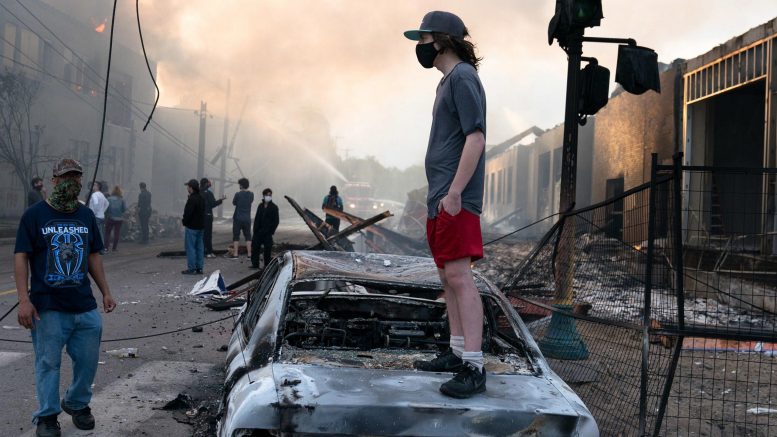
A man stands on a burned-out car as fires burn behind him in the Lake Street area of Minneapolis, Minnesota, May 28, 2020. Credit: Lorie Shaull/Wikimedia Commons
How Cliodynamics Can Chart Social Dynamics
Beginning in May 2020, after George Floyd, a Black American man, died in police custody, ‘Black Lives Matter’ demonstrations and riots engulfed the United States, the United Kingdom, and several European countries. Though Mr. Floyd’s killing served as the immediate catalyst for the unrest, many scholars suggest that the COVID-19 pandemic and the resulting economic crisis played a deeper, more pivotal role in creating conditions that led to the protests.
There has been a steady increase in protests in the United States and Great Britain since 2011, which, as Peter Turchin and other scientists suggest, is the result of a predictable 50-year cycle of socio-political dynamics that has culminated with a surge of violence. This cycle was identified by Russian experts in cliodynamics and structural-demographic theory. Back in 2010, they predicted the current course of events. And now they have been able to verify their mathematical models.
In 2010, the Russian-American scientist Peter Turchin used structural-demographic theory (SDT) to predict the dynamics of socio-political conditions in the United States and Western Europe until 2020. His model predicted that, over the next decade, political instability and an increase in social conflicts would occur in Western democracies. In a new article, Turchin, together with Andrey Korotayev, another leading specialist in SDT at HSE University, conducted a retrospective assessment of the forecasts made in 2010-2012 and confirmed the accuracy of the conclusions. The paper was published in PLoS ONE journal.
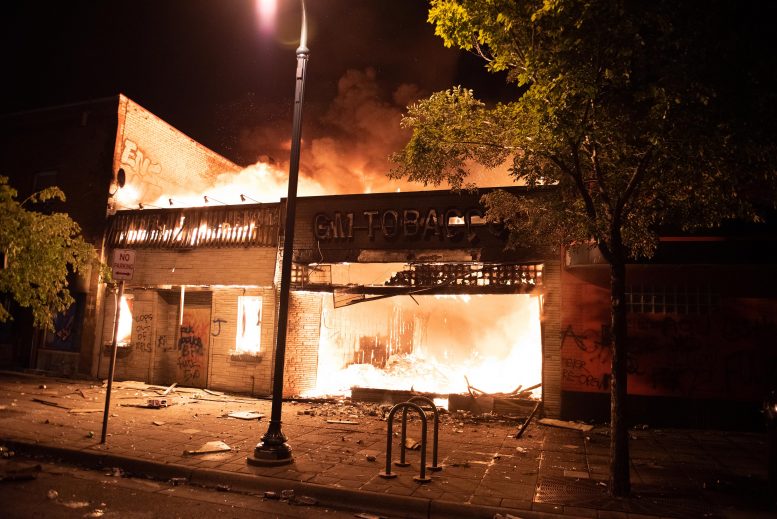
Following the death of George Floyd, GM Tobacco on Lake Street was among the businesses that were set ablaze on May 28, 2020. GM Tobacco was next door to Minnehaha Lake Wine and Spirits and near the Minneapolis 3rd Police Precinct, which were both also set on fire.
The following approach is applied: the postulated historical hypothesis is turned into a mathematical model. It is then calculated. A specific prediction is extracted from the model. This forecast is then tested on real historical events. Thus, mathematical models can be tweaked, fine-tuned and, as a result, provide fairly accurate predictive analytics.
Historians are helped by the theory of complex systems, originally developed by physicists to describe nonlinear, chaotic processes, which can be used for climate modeling and weather prediction, for example. The American sociologist and historian Jack Goldstone was the first scholar to apply a mathematical apparatus from the theory of complex systems to historical processes. He developed the structural-demographic theory (SDT), which made it possible to take into account the many forces interacting in society that put pressure on it and lead to riots, revolutions, and civil wars.
Using the SDT, Goldstone established that every major coup or revolution is preceded by a surge in fertility. As a result, the size of the population exceeds its economic possibilities for self-sufficiency. A crisis comes, the population’s standard of living the drops sharply, and unrest begins. At the same time, the state loses political flexibility and the elites split, with some of them siding with the protesters against the current system. A coup takes place, usually accompanied by an explosion of violence and a civil war.
Later, Goldstone’s ideas were picked up and developed by Russian scientists and scholars, including not only Peter Turchin but also Sergei Nefyodov, Leonid Grinin and HSE Professor Andrei Korotayev. They applied their developments to predict socio-historical dynamics in the United States and Great Britain, as well as other Western European countries.
Structural demographic theory consists of four main components:
- the state (size, income, expenses, debts, the legitimacy of power, etc.);
- population (size, age structure, urbanization, wage level, social optimism, etc.);
- elites (number and structure, sources of their income and current welfare, conspicuous consumption, internal competition, social norms);
- factors of instability (radical ideologies, terrorist and revolutionary movements, acts of violence, riots, and revolutions).
Goldstone himself also proposed methods to operationalize and measure them, as well as a general integral indicator that allows future unrest to be predicted–an indicator of political stress Ψ (PSI, or the political stress indicator). Retrospective studies have shown that Ψ was off the charts before the French Revolution, the English Civil War, and the crisis of the Ottoman Empire. Therefore, if the mathematical model shows the growth of Ψ curve at any time intervals in the future, then we can confidently speak about coming socio-political instability at this time in this region.
In general terms, the equation for calculating Ψ looks like this:
Ψ = MMP * EMP * SFD
Here, MMP stands for Mass Mobilization Potential, EMP stands for Elite Mobilization Potential, and SFD represents the level of State Fiscal Distress in the state. Each of the equation indicators is calculated separately using many other socio-demographic variables and various mathematical tools, including differential equations.
In a new paper, scientists drew information from the Cross-National Time-Series Data Archive (CNTS) database. It contains information on the 200 most important indicators for more than 200 countries around the world from 1815 to the present. The researchers were most interested in data on anti-government demonstrations, riots, government crises, revolutions and purges (although for the United States and Great Britain there is little data for reliable statistical analysis with regard to the last two phenomena). An independent dataset from the US Political Violence Database (USPVD) and an archive of publications from The New York Times were also used to check and correct the information.
It turned out that in full accordance with the forecasts for 2010-2012 in the United States over the past 10 years, the number of anti-government demonstrations has sharply increased, and the number of street riots has increased significantly (see graph below). It is important to note that the prediction made at that point in time was completely at variance with the current trends and could not be a simple extrapolation, since from the early 1980s to 2010 the level of social unrest remained consistently low.
It is important to note that the events of 2020 do not affect or change the simulation results in any way. All the trends that have clearly manifested themselves in the USA, Great Britain, and a number of European countries have been slowly but steadily growing throughout the decade. The COVID-19 pandemic, of course, has also had an impact, and it was impossible to predict it based on historical data (although virologists and epidemiologists have regularly written about the potential danger of coronaviruses in scientific periodicals since the 2000s). But epidemics of dangerous diseases often arise during periods of social crisis and hit the most vulnerable sectors of society (as happened in the United States), which only mobilizes the masses even more and takes them to the streets.
Reference: “The 2010 structural-demographic forecast for the 2010–2020 decade: A retrospective assessment” by Peter Turchin and Andrey Korotayev, 17 August 2020, PLoS ONE.
DOI: 10.1371/journal.pone.0237458


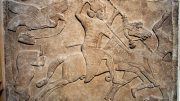

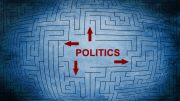


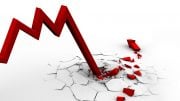

Is there a comparable theory for other forms of government i.e Communist dictatorship etc?
Since when troll factories are good at predictions, lol
I don’t understand why they’re not throwing the protestors in prison! They’re not peaceful at all! Destroying property, lighting fires, looting, etc. is not peaceful and it’s okay to do that just because somebody died.
You completely miss the historical context of the events. More often than not, the protests begin completely peacefully, and then the violence is instigated by agents provocateurs. The agents provocateurs, once unmasked, are either operatives from the opposite side of the political spectrum from the protesters or agents of either the state or federal governnment acting in furtherance of a repressive agenda.
Look at the history of the Oakland Induction Center protests of the late sixties for evidentiary support of this. There’s plenty of it.